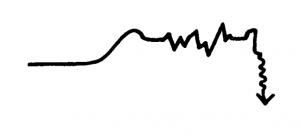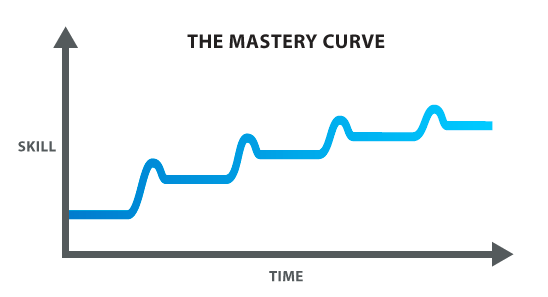The Mastery Curve
There is a wonderful book entitled Mastery: The Keys to Success and Long-Term Fulfillment by George Leonard. In it he describes the journey he took as a 47 year old beginner in the martial art of Aikido. This is a fantastic book that every martial artist should read.
We live in a culture that stresses immediate gratification and instant perfection. Yet, the pursuit of martial arts is a long process, a journey that will wind its way slowly through one’s life. There is no immediacy. As we travel this long slow journey, we will often encounter plateaus. Yes, the dreaded “P” Word. No one likes to hear it and we enjoy them less when we experience it. This is the place; however, we will spend most of our life as a martial artist in pursuit of “mastery”. So, we have to ask as Leonard proposes in his book, “Where in our upbringing, our schooling, our career are we explicitly taught to value, to enjoy, even to love the “plateau”, the long stretch of diligent effort with no seeming progress?”
Many keys to mastery exist and Leonard explains them in detail but the first is to recognize the type of person you are; Dabbler, Obsessive, or Hacker.
The Dabbler
The Dabbler tries many things but is never satisfied with any of them, none of them “fit” her style.
The Obsessive
The Obsessive goes all out, 110% into the pursuit and exceeds everyone’s expectations for a short time, then comes against a wall and flails about for some time until he completely stops trying and moves on to the next obsession.
The Hacker
The Hacker enjoys the activity and progresses to a medium level of competency but does not get any better, he is satisfied with mediocrity. None of these profiles will give you feelings of satisfaction or accomplishment.
If you recognize yourself in any of these profiles, do not fear there is a fourth type: ∫.
The Master
In George Leonard’s book, this is what he says about mastery:
Learning any new skill involves relatively brief spurts of progress, each of which is followed by a slight decline to a plateau somewhat higher in most cases the than which preceded it. The curve (below) is necessarily idealized. In the actual learning experience, progress is less regular; the upward spurts vary; the plateaus have their own dips and rises along the way. But the general progression is almost always the same. To take the masters journey, you have to practice diligently, striving to hone your skills, to attain new levels of competence. But while doing so – and this is the inexorable fact of the journey – you also have to be willing to spend most of your time on a plateau, to keep practicing even when you seem to be getting nowhere. (p14-15)
The Master realizes there will be a slow climb to the top and they will hit many plateaus along the way. You will eventually break through those plateaus with prolonged practice and determination but will also perceive a decline in abilities. Yes, it will feel like your skills have gone down for a time. If we were to graph the Master’s Journey, it would look like the picture below. This should not be discouraging as you will see that you are still progressing upward. It is slow and methodical, and yes, sometimes boring but you are making progress.
This is the journey to Mastery in anything we participate in, especially martial arts because of the intrinsic nature of the arts. The Black Belt Champion (Attitude) and a spirit of perseverance (that Indomitable Spirit) will help immensely along the way by providing focus and discipline.
David Campbell said, “Discipline is remembering what you want.”
Have the discipline to know that the Master’s Journey is rewarding and the end result will be far greater than anything you can currently perceive.





